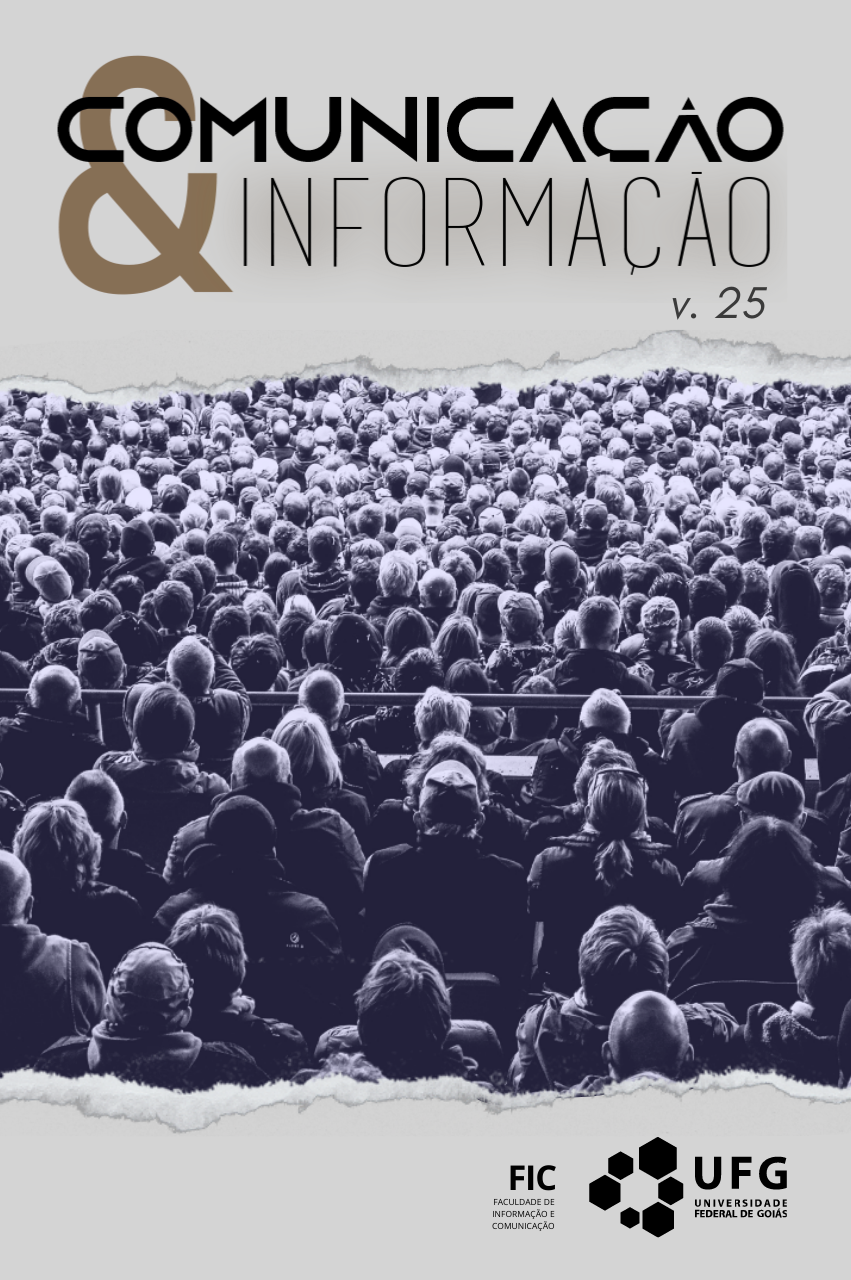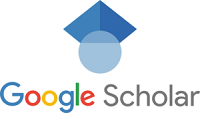Influential Factors in the Mathematical Formulation of the Journal Impact Factor
DOI:
https://doi.org/10.5216/ci.v25.63496Keywords:
Communication and Information. Scientific Production. Journal Scientific Evaluation. Journal Impact factor.Abstract
This research aimed to identify the main factors that influence the mathematical formulation of the Journal Impact Factor. It adopted a bibliographic research for the theoretical foundation and collection of information of the works and authors. The results showed that the types of documents, citation number distribution, database coverage, numerical value and Bradford law fundamentals, gather theoretical bases that influence the mathematical formulation of the calculation of this indicator. In this context, it is emphasized the need for the development of Brazilian studies that contribute to the reflections, discussions and improvement of the knowledge related to the Impact Factor and its implications mainly in the applied social sciences areas.
Downloads
References
ALLISON, P. D. Discrete-time methods for the analysis of event histories. Sociological Methodology, USA, v. 13, p. 61-98,1982. Disponível em: https://statisticalhorizons.com/w p-content/uploads/Allison.SM82.pdf. Acesso em: 10 maio 2016.
ALLISON, P. D.; WATERMAN, R. P. Fixed-effects negative binomial regression models. Sociological Methodology, USA, v. 32, p. 247-265, 2002. doi: 10.1111/1467-9531.00117.
ALMEIDA, C. C; GRÁCIO, M. C. C. Scientific impact indicator: a comparative study of Brazilian Journals’ impact factors. In: INTERNATIONAL CONFERENCE ON SCIENCE AND TECHNOLOGY INDICATORS, 21., 2016a, València. Proceedings […].València: Editorial Universitat Politecnica de Valencia, 2016a.
ALMEIDA, C. C; GRÁCIO, M. C. C. Impacto dos periódicos brasileiros na área de Ciências Sociais: um estudo comparativo entre as bases Scopus e SciELO. In: ENCONTRO NACIONAL DE PESQUISA EM CIÊNCIA DA INFORMAÇÃO, 17., 2016b, Salvador. Anais [...]. Salvador: ENANCIB, 2016b.
ALMEIDA, C. C; GRACIO, M. C. C. Citações de artigos em periódicos em de Ciência da Informação: uma análise da distribuição na base Scopus. In: ENCONTRO NACIONAL DE PESQUISA EM CIÊNCIA DA INFORMAÇÃO, 18., 2017a, Marília, SP. Anais [...]. Marília, SP: ENANCIB, 2017a. Disponível em: http://www.brapci.inf.br/index.php/article/download/58891. Acesso em: 10 maio 2018.
ALMEIDA, C. C; GRACIO, M. C. C. Factor de impacto de revistas de la América Latina en Ciencia Social: Un estudio comparativo entre las bases Scopus y Web of Science. Revista Científica Guillermo de Ockham, Columbia, v. 15, n. 2, p. 1-13, 2017b. Disponível em: https://revistas.usb.edu.co/index.php/GuillermoOckham/issue/view/256. Acesso em: 15 maio 2018.
ARCHAMBAULT, E.; LARIVIÈRE, V. History of the journal impact factor: Contingencies and consequences. Scientometrics, Netherlands, v. 79, n. 3, p. 639–653; 2009. doi: 10.1007/s 11192-007-2036-x.
BARATA, R. C. B. Dez coisas que você deveria saber sobre o Qualis. RBPG, Brasília, v. 13, n. 30, p. 13-40, jan./abr. 2016. Disponível em: ojs.rbpg.capes.gov.br
/index.php/rbpg/article/download/947/pdf. Acesso em: 20 nov. 2016.
BENSMAN, S. J. Garfield and the impact factor. Annual Review of Information Science and Technology, New York, v. 41, n. 1, p. 93-155, 2007. Disponível em: http://onlinelibrary.wiley.com/doi/10.1002/aris.2007.1440410110/pdf Acesso em: 12 dez. 2017.
BRADFORD, S C. Sources of information on specific subjects. Engineering, London, v. 137, n. 85-6, 1934.
BRAUN, T.; GLÄNZEL, W.; SCHUBERT, A. The footmarks of Eugene Garfield in the journal Scientometrics. Annals of Library and Information Studies, India, v. 57, p. 177-183, 2010. Disponível em: http://nopr.niscair.res.in/bitstream/123456789/10231
/4/ALIS%2057(3)%20177-183.pdf. Acesso em: 10 mar. 2018.
CANTRILL, S. Nature Chemistry’s 2014 impact factor citation distribution. Nature Chemistry, Blog The Sceptical Chymist, 2015. Disponível em: http://blogs.nature.com/thescepticalchymist/2015/12/nature-chemistrys-2014-impact-factor
-citation-distribution.html. Acesso em: 15 maio 2018.
CLARIVATE ANALYTICS. The clarivate analytics impact factor. Clarivate, 2018. Disponível em: https://clarivate.com/essays/impact-factor/. Acesso em: 5 jan. 2018.
DE BELLIS, N. Bibliometrics and citation analysis: from the science citation index to cybermetrics. Toronto: The Scarecrow Press, 2009.
DONG, P.; LOH, M.; MONDRY, A. The "impact factor" revisited. Biomedical Digital Libraries, United Kingdom, v. 2, n. 7, 2005. Disponível em: https://bio-diglib.biomedcentral. com/articles/10.1186/1742-5581-2-7. Acesso em: 12 nov. 2016.
DURAND-BARTHEZ, M. Historique et critique du facteur d’impact. Schedae, France, v. 7, n. 1, p. 67-76, 2008. Disponível em: https://hal.archives-ouvertes.fr/hal-01356185/document. Acesso em: 20 fev. 2018.
FERNANDÉZ-LLIMÓS, F. S. Análisis de la cobertura del concepto de pharmaceutical care en fuentes primarias y secundarias de información. 2003. 266 f. Tesis (Farmacia Asistencial) - Universidad de Granada, Departamento de Farmacia y Tecnologia Farmacéutica, Granada, 2003.
GARFIELD, E. Citation indexes for science: A new dimension in documentation through association of ideas. Science, USA, v. 122, n. 3159, p. 108–11,1955. Disponível em: http://garfield.library.upenn.edu/papers/science1955.pdf. Acesso em: 10 dez. 2017.
GARFIELD, E.; SHER, I. H. New factors in the evaluation of scientific literature through citation indexing. American Documentation, USA, v. 4, n. 3, p. 195-201, 1963. Disponível em: http://garfield.library.upenn.edu/essays/v6p492y1983.pdf. Acesso em 11 nov. 2017.
GARFIELD E. Citation analysis as a tool in journal evaluation. Science, USA, v. 17, p. 471-479, 1972a. Disponível em: http://www.garfield.library.upenn.edu/essays/V1p527
y1962-73.pdf. Acesso em 11 nov. 2017.
GARFIELD E. Citation statistics may help scientists choose journals in which to publish. Current Contents, Philadelphia, v. 6, p. 5-6, 1972b. Disponível em: http://www.garfield. library.upenn.edu/. Acesso em: 11 nov. 2017.
GARFIELD E. Is the ratio between number of citations and publications cited a true constant? Current Contents, Philadelphia, v. 6, n. 5-7, 1976. Disponível em: http://garfield.library.upenn.edu/essays/v2p419y1974-76.pdf. Acesso em: 12 dez. 2017.
GARFIELD E. Reviewing review literature part.1 definitions and uses of reviews. Current Contents, Philadelphia, n. 18, p. 5-8; 1987. Disponível em: http://www.garfield.library.upenn.edu/essays/v10p113y1987.pdf. Acesso em: 12 dez. 2017.
GARFIELD E. Journal impact factor: a brief review. Canadian Medical Association Journal, Canadian, v. 161, n. 8, p. 979-980, 1999. Disponível em: http://www.garfield.library.upenn.edu/papers/JournalimpactCMAJ1999.pdf. Acesso em: 20 nov. 2017.
GLÄNZEL, W. Bibliometrics as a research field: a course on theory and application of bibliometric indicators. Budapeste: Academia Húngara de Ciências, 2003.
GLÄNZEL, W. The multi-dimensionality of impact factor. Scientometrics, Netherlands, v. 78, 2009. doi: 10.1007/s11192-008-2166-9.
GLÄNZEL, W.; MOED, F. H. Opinion paper: thoughts and facts on bibliometric indicators. Scientometrics, Netherland, v. 96, n. 1, p. 381-394, 2013. doi: 10.1007/s11192-012-0898-z.
GOTTLIEB, L. N.; CLARKE, S. P. Impact factors and the law of unintended consequences. CJNR, Montréal, v. 37, n. 4, p. 5-10, 2005. Disponível em: cjnr.archive.mcgill.ca/article/download/1967/1961. Acesso em 22 fev. 2018.
HAMILTON, D. Publishing by–and for? – the numbers. Science, Washington, v. 250, n. 4986, p. 1331-1332, 1990. doi: 10.1126/science.2255902.
LARIVIÈRE, V.; KIERMER, V.; MACCALLUM, J. C.; MCNUTT, M.; PATTERSON, M.; PULVERER, B.; SWAMINATHAN, S.; TAYLOR, S.; CURRY S. A simple proposal of journal citation distributions. bioRxiv, New York, 2016. doi: 10.1101/062109.
LIU, X-L; GAI, S-S; ZHANG, S-L; WANG, P. An Analysis of peer-reviewed scores and impact factors with different citation time windows: a case study of 28 Ophthalmologic Journals. PLOS ONE, USA, v. 10, n. 8, 2015. Disponível em: https://journals.plos.org/Plosone/article?id=10.1371/journal.pone.0135583. Acesso em: 9 dez. 2017.
MACIAS-CHAPULA, C. A. O papel da informetria e da cienciometria e sua perspectiva nacional e internacional. Ciência da Informação, Brasília, v. 27, n. 2, p.134-40, maio/ago. 1998.
MOED, H; VAN LEEUWEN, T. Improving the accuracy of Institute for Scientific Information’s Journal impact factors. Journal of the American Society for information Science, USA, v. 46, n. 6, p. 461-467, 1995. Disponível em: https://doi.org/10.1002/(SICI)1097-4571(199507)46:6<461::AID-ASI5>3.0.CO;2-G. Acesso em: 22 mar. 2017.
MOED, H.; VAN LEEUWEN, T. Impact factors can mislead. Nature, United Kingdom, v. 381, n. 186, 1996. Disponível em: https://www.nature.com/articles/381186a0. Acesso em:
abr. 2017.
MURALI, N. S; MURALI, H. R; AUETHAVEKIA, T. P.; ERWIN, P. J.; MANDREKAR, J. N.; MANEK, N. J; GHOSH, A.K. Impact of FUTON and NAA bias on visibility of research. Mayo Clinic Porceedings, USA, v. 79, n. 8, p. 1001-1006, 2004. doi: 10.4065/79.8.1001.
POTTER, I. Beyond the impact factor: taking a wider view of journal evaluation. Insights: the UKSG Journal, United Kingdom, v. 29, n. 1, p. 70–77, 2016. Disponível em: https://insights.uksg.org/articles/10.1629/uksg.287/. Acesso em: 15 maio 2018:
SEGLEN, P.O. Citations and journal impact factors: questionable indicators of research quality. Allergy, Germany, v. 52, v. 11, p. 1050-1056, 1997. Doi: 10.1111/j.1398-9995.1997.tb00175.x
SEN, B. K. Changes in impact factor. Malaysian Journal of Library & Information Science, Malaya, v. 4, n. 2, p. 41-46, 1999. Disponível em: http://majlis.fsktm.um.edu.my/
document.aspx?FileName=147.pdf. Acesso em: 15 dez. 2017.
SEN, B. K. Eugene Garfield–Glimpses of his writings. Journal Scientometric Research, Índia, v. 3, n. 1, 2014. Disponível em: https://www.jscires.org/sites/default/files/JSci
Res_2014_3_1_57_143709.pdf.Acesso em 15 dez. 2017.
SCHUBERT, A.; SCHUBERT, G. Whatever happened to Garfield’s constant? Scientometrics, Netherlands, v. 114, n. 2, p. 659-667, 2018. doi: 10.1007/s11192-017-2527-3.
SIMONS, K. The misused Impact Factor. Science, USA, v. 322, n. 5899, p. 165, 2008. doi: 10.1126/science.1165316.
SMIT, E. S. Obsolescence and impact on reliability: a further development of internet triangulation. Work Completion of Course (Bachelor in International Business Administration) - University of Twente, Enschede, Países Baixos, 2017. Disponível em: https://essay.utwente.nl/72544/1/Smit_BA_BMS%5B1%5D.pdf. Acesso em: 10 fev. 2018.
SPINAK, E. Indicadores cienciométricos. Brasília, Ciência da Informação, v. 27, n. 2, p. 141-148; 1998.
VAN LEEUWEN, T.; MOED, H. Development and application of New Journal Impact Measures. Cortex, France, v. 37, n. 4, p. 607-610, 2001. doi: 10.1016/S0010-9452(08)70607-5.
VAN LEEUWEN, T.; MOED, H. Development and application of journal impact measures in the Dutch science system. Scientometrics, Netherlands, v. 53, p. 249, 2002. doi: 10.1023/A:1014808709694.
VAN LEEUWEN, T.; MOED, H. Characteristics of journal impact factors: The effects of uncitedness and citation distribution on the understanding of journal impact factors. Scientometrics, Netherlands, v. 63, n. 2, p. 357-371, 2005. doi: 10.1007/s11192-005-0217-z.
VAN LEEUWEN, T. Discussing some basic critique on Journal Impact Factors: revision of earlier comments. Scientometrics, Netherlands, v. 92, p. 443–455, 2012. doi: 10.1007/s11192-012-0677-x.
VANCLAY, J. K. Bias in the journal impact factor. Scientometrics, Netherlands, v. 78, n. 1, p. 3-12, 2009. doi: 10.1007/s11192-008-1778-4.
VINKLER, P. Model for quantitative selection of relative scientometric impact indicators. Scientometrics, Netherlands, v. 36, p. 223-236, 1996. doi: 10.1007/bf02017315.
VINKLER, P. Subfield problems in applying the Garfield (Impact) Factors in practice. Scientometrics, Netherlands, v. 53, n. 2, p. 267-279, 2002. doi: 10.1023/A:1014860726532.
VINKLER, P. Relations of relative scientometric indicators. Scientometrics, Netherlands, v. 58, n. 3, p. 687-694, 2003. doi: 10.1023/B:SCIE.0000006888.69146.24.
WALTMAN, L. A review of the literature on citation impact indicators. Journal of Informetrics, Netherlands, v.10, n. 2, p. 365-391, 2016. doi: 10.1016/j.joi.2016.02.007.
WEALE, A. R.; BAILEY, M.; LEAR, P. A. The level of non-citation of articles within a journal as a measure of quality: a comparison to the impact factor. BMC Medical Research Methodology, United Kingdom, v. 4, n. 14, 2004. Disponível em: https://bmcmed
resMethodol.biomedcentral.com/articles/10.1186/1471-2288-4-14. Acesso: 15 abr. 2018.
WHITEHOUSE, G.H. Citation rates and impact factors: should they matter? The British Journal of Radiology, United Kingdom, v. 74, n. 877, p. 1-3, 2001. doi: 10.1259/bjr.74.877.740001.
WOUTERS, P. The citation culture. 1999. 278 f. Tese (Doutorado em Ciências) University of Amsterdan, Faculty of Science, Netherlands, 1999. Disponível em: https://dare.uva.nl/Search?identifier=b101b769-100f-43e5-b8d2-cac6c11e5bbf.
Acesso em: 22 nov. 2017.
Downloads
Published
How to Cite
Issue
Section
License
Os autores dos trabalhos publicados na revista Comunicação e Informação retêm os direitos autorais sem restrições e concedem à revista o direito de primeira publicação, com o trabalho simultâneo licenciado sob a Licença Creative Commons Atribuição-NãoComercial que permite o compartilhamento do trabalho para fins não comerciais com reconhecimento da autoria e o privilégio de publicação primeiramente por esta revista. Caso o texto venha a ser publicado posteriormente em outro veículo, solicita-se aos autores informar que o mesmo foi originalmente publicado como artigo na revista Perspectiva, bem como citar as referências bibliográficas completas dessa publicação.
Os direitos autorais dos artigos pertencem aos autores e o conteúdo dos artigos assinados é de responsabilidade exclusiva dos autores.
A revista se reserva o direito de efetuar, nos originais, alterações de ordem normativa, ortográfica e gramatical, com o intuito de manter o padrão culto da língua, respeitando, porém, o estilo dos autores.
A revista também se reserva o direito de traduzir o artigo, no todo ou em parte, para o inglês ou para o português, dependendo do idioma em que o artigo tenha sido escrito originalmente.



